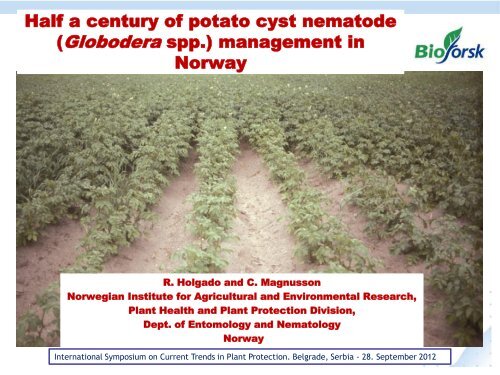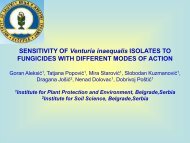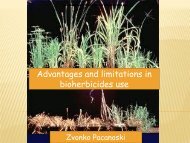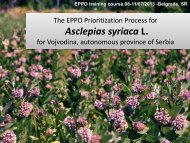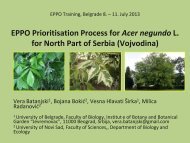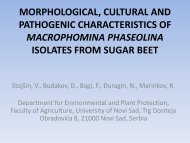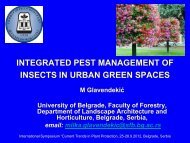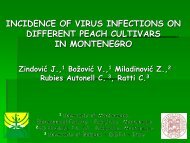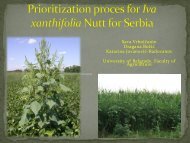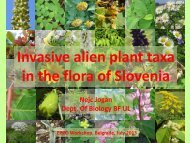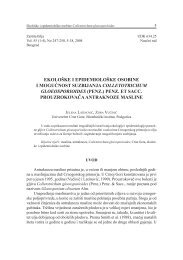Half a century of potato cyst nematode (Globodera spp ... - Izbis
Half a century of potato cyst nematode (Globodera spp ... - Izbis
Half a century of potato cyst nematode (Globodera spp ... - Izbis
Create successful ePaper yourself
Turn your PDF publications into a flip-book with our unique Google optimized e-Paper software.
<strong>Half</strong> a <strong>century</strong> <strong>of</strong> <strong>potato</strong> <strong>cyst</strong> <strong>nematode</strong><br />
(<strong>Globodera</strong> <strong>spp</strong>.) management in<br />
Norway<br />
R. Holgado and C. Magnusson<br />
Norwegian Institute for Agricultural and Environmental Research,<br />
Plant Health and Plant Protection Division,<br />
Dept. <strong>of</strong> Entomology and Nematology<br />
Norway<br />
International Symposium on Current Trends in Plant Protection. Belgrade, Serbia - 28. September 2012
Presentation summary<br />
• Overview <strong>of</strong> <strong>potato</strong> production<br />
Background <strong>of</strong> <strong>potato</strong> <strong>cyst</strong> <strong>nematode</strong> (PCN) in Norway<br />
PCN surveys<br />
• PCN in Norway – Current Situation<br />
• Current PCN management in Norway<br />
Statutory regulations<br />
The <strong>potato</strong> cultivation standard<br />
PCN and certified seed <strong>potato</strong><br />
Identification to species level<br />
Identification <strong>of</strong> pathotypes<br />
Resistance-breaking pathotypes<br />
Potential for using trap crops<br />
Occurrence and pathogenicity <strong>of</strong> microbial antagonists parasitic to PCN<br />
• Conclusions
Potato cultivation in Norway<br />
• Farmers in Norway have<br />
cultivated <strong>potato</strong> for more<br />
than 250 years.<br />
• In 2008 the total <strong>potato</strong><br />
acreage was 14 400 Ha.<br />
• The total <strong>potato</strong> production<br />
398 000 tonn<br />
• The annual production value<br />
in <strong>potato</strong> <strong>of</strong> approximately<br />
600 millions NOK (75 millions<br />
Euro). www.ssb.no
G. rostochiensis and G. pallida are quarantine<br />
pests.<br />
• In Norway all pathotypes <strong>of</strong> G. pallida and most pathotypes <strong>of</strong><br />
G. rostochiensis except pathotype Ro1 are considered<br />
virulent.<br />
• Non-virulent G. rostochiensis is managed by crop rotation<br />
using non-host crops; alternating susceptible and resistant<br />
cultivars.<br />
• Infestations by G. pallida or virulent G. rostochiensis results<br />
in 40-years ban on growing <strong>potato</strong>
Background <strong>of</strong> <strong>potato</strong> <strong>cyst</strong> <strong>nematode</strong><br />
(PCN) in Norway<br />
• In 1955 the <strong>potato</strong> <strong>cyst</strong> <strong>nematode</strong> was recorded for the first<br />
time in Agder. This detection produced the initial legislation<br />
<strong>of</strong> PCN control, and was implemented based on the statutory<br />
regulation <strong>of</strong> 1916.<br />
• Since 1956 PCN was given quarantine status in infested<br />
agricultural land and home gardens.<br />
• The 1956 PCN legislation stipulated measures in event <strong>of</strong><br />
finding infestation.<br />
• The growing <strong>of</strong> ware <strong>potato</strong>es were restricted to at least 4<br />
year rotation, and prohibited the unauthorised movement <strong>of</strong><br />
infested soil, by any means, to prevented spread to adjacent<br />
areas.<br />
• This detection resulted in extensive surveys.
PCN surveys<br />
• Surveys started in 1955; and were carried uninterrupted until<br />
the end <strong>of</strong> the 1990ties.<br />
• These surveys included producing <strong>potato</strong> agricultural land<br />
and home gardens.<br />
• In 2009 a new national survey program for the principal<br />
<strong>potato</strong> districts has started, the surveys is aimed to update<br />
the PCN occurrence.<br />
• The surveys will continue during the subsequently years until<br />
all major <strong>potato</strong> areas will be cover.<br />
• Records <strong>of</strong> all PCN infested land in Norway have been<br />
retained since 1955, so decline rates and local spread can be<br />
monitored
Sampling to estimate PCN occurrence and<br />
density for statutory and advisory purpose<br />
Type <strong>of</strong><br />
Sample<br />
Number<br />
<strong>of</strong> cores<br />
per<br />
sample<br />
Total<br />
bulked<br />
sample<br />
Area to<br />
provide<br />
one bulk<br />
sample<br />
Patterns <strong>of</strong> cores<br />
grid (Core size 25.0<br />
x 2.5 cm)<br />
Routine 100 500 ml 1 ha Line distance 10 m<br />
Certified<br />
<strong>potato</strong><br />
100 500 ml 0.5 ha Line distance 7 m<br />
In stored<br />
Min. 30 Min. 1 sample per<br />
packing<br />
250 ml tonnes consignment<br />
houses <strong>of</strong><br />
ware<br />
<strong>potato</strong>es<br />
<strong>of</strong> <strong>potato</strong>
Occurrence <strong>of</strong> PCN in Norway (farms and<br />
home gardens), analysed during 1955-<br />
2000.<br />
Number <strong>of</strong> properties with PCN Analysed samples<br />
Home Farms Without Total With Without Total<br />
gardens information PCN PCN<br />
(% )*<br />
(%)**<br />
Total 2979 1785 1642 6406 4554 84 608 89 162<br />
(47)<br />
(5)<br />
* % in relation to the total proprieties with PCN (farms + home gardens)<br />
** % in relation to the total <strong>of</strong> samples analysed
Analysed samples in 2010<br />
County Total samples With PCN (%) Without PCN (%)<br />
Aust- Agder 475 35(7,3) 430 (92,7)<br />
Vest-Agder 99 17 (17,17) 82 (82,8 )<br />
Rogaland 385 85 (22, 0 %) 300 (78,0 %)<br />
Nord-Trøndelag 906 3 (0,33 %) 903 (99,6 %)<br />
Hedmark<br />
(packing houses)<br />
725 12 (1,6 %) 713 (98,4 %)<br />
2590 (100 %) 152 (6 %) 2438 (94 %)
Occurrence <strong>of</strong> PCN in Norway<br />
• 1955:Agder-county<br />
• 1976: Southern Counties<br />
from Dovre (with exception<br />
<strong>of</strong> Hedmark county)<br />
• 1985: Municipality <strong>of</strong> Møre<br />
and Romsdal, Hedmark, and<br />
Sør Trøndelag.<br />
• 1993:Nord Trøndelag<br />
municipality <strong>of</strong> Frosta<br />
• 2004:Municipality <strong>of</strong><br />
Stjørdal.<br />
http://webgis.no/potet<strong>cyst</strong>e_<strong>nematode</strong>r/
PCN Management<br />
• The management <strong>of</strong> PCN has been based mainly on regulatory<br />
restrictions.<br />
• Commercial chemical fumigants, organophosphates or carbamate<br />
nematicides have not been used in Norway since the early 1970s.<br />
• Today, policy to manage G. rostochiensis Ro1 is still crop rotation using<br />
non-host crops, and alternating between susceptible and resistant<br />
cultivars every 4 years. This recommendation includes the use <strong>of</strong><br />
certified seed.<br />
• The 4 years rotations are complicated by restricted acreage.<br />
• Infestations by (G. pallida) or virulent (G. rostochiensis) results in 40years<br />
ban on growing <strong>potato</strong>.<br />
• Most Norwegian <strong>potato</strong> cultivars have the resistance genes, Gro-1 (H 1)<br />
from Solanum tuberosum ssp. andigena.<br />
• In the preceding decades great emphasis has been placed on<br />
documenting freedom from PCN in the production <strong>of</strong> certified seed and<br />
on the detection <strong>of</strong> infested fields and their placement under effective<br />
quarantine regulations.<br />
• In the early 1960ties import and movement <strong>of</strong> all kind <strong>of</strong> <strong>potato</strong> seed<br />
was prohibited, as a measure to prevent the introduction <strong>of</strong> new PCN<br />
populations, and to prevent contamination <strong>of</strong> uninfested land.
Statutory regulations from 1956-1990<br />
• PCN initial legislation 1956 :Potato or tomato cultivation every 4<br />
year, prohibited soil or infected plants to be moved.<br />
• In 1962 : the regulation prohibited the movement <strong>of</strong> equipment and<br />
machinery used in the infected area. Unless it was cleaned,<br />
inspected and found free <strong>of</strong> PCN.<br />
• In 1970: the PCN regulation included the use <strong>of</strong> PCN resistant <strong>potato</strong><br />
cultivars. For using resistant cultivars a surveillance and <strong>of</strong>ficial<br />
control <strong>of</strong> the infected areas was recommended, and the use <strong>of</strong><br />
chemical fumigants in highly infested fields.<br />
• In 1977: the taxonomic separation <strong>of</strong> G. rostochiensis and G.<br />
pallida, together with emerging information on the existence <strong>of</strong><br />
pathotypes was taken into consideration, and recommended a<br />
controlled use <strong>of</strong> resistant cultivars, to avoid the increase <strong>of</strong><br />
resistant breaking pathotypes.<br />
• In 1990: incorporated a prohibition <strong>of</strong> growing <strong>potato</strong>es in areas<br />
with G. pallida or virulent G. rostochiensis, and included further<br />
the possibility <strong>of</strong> imposing a ban on growing <strong>potato</strong> in areas close to<br />
the farms, or on farms sharing equipment or machinery with<br />
infested farms.
Statutory regulations from 1990-2010<br />
• In 1998: included measures for <strong>potato</strong> manufacturing facilities; if<br />
PCN was found, sanitary measures are compulsory to the houses<br />
committed to packing <strong>potato</strong>es. For farmers the movement <strong>of</strong> their<br />
own seed <strong>potato</strong>es from packing houses was prohibited.<br />
• Also the possibility <strong>of</strong> economic compensation for farms affected<br />
with a ban for growing <strong>potato</strong>es is mentioned.<br />
• In 2000: the PCN regulation stipulated that all <strong>potato</strong> producers and<br />
manufacturing facilities must be <strong>of</strong>ficially listed and have an internal<br />
control system for PCN management, including preventive measures<br />
against its dissemination. The regulation mentioned the possibility<br />
<strong>of</strong> a long quarantine period for resistance breaking PCN populations,<br />
in practice more than 40 years due to the long persistence <strong>of</strong> PCN in<br />
the absence <strong>of</strong> host plants.<br />
• Recently in April 2010: a new regulation was introduced prescribing<br />
surveillance and <strong>of</strong>ficial control <strong>of</strong> PCN-infected and non-infected<br />
areas where <strong>potato</strong>es are produced. This new strategy implies the<br />
demarking and regulation <strong>of</strong> the area actually infested.
Statutory regulations from 2010 - 2012<br />
• This new strategy implies the demarking and regulation <strong>of</strong> the area actually<br />
infested. The owner/tenant <strong>of</strong> property with PCN must have the knowledge<br />
about PCN and the distribution <strong>of</strong> PCN on the farm land.<br />
• All owners/tenants have the responsibility to limit and/or prevent the spread<br />
<strong>of</strong> PCN. All PCN populations on infested areas shall be reduced.<br />
• The statutory regulation for PCN form 2010 has created a new challenge for<br />
<strong>potato</strong> production, the Norwegian <strong>potato</strong> industry and <strong>potato</strong> growers has<br />
generated a standard for <strong>potato</strong> cultivation to prevent the increasing<br />
problems with PCN.<br />
• The <strong>potato</strong> cultivation standard just has started to be put in practice and will<br />
be compulsory from 2013.
The <strong>potato</strong> cultivation standard<br />
• The standard gives a description <strong>of</strong> measures that <strong>potato</strong><br />
growers should take to meet the requirements for PCN<br />
regulations from the Norwegian Food Safety Authority, and<br />
focus on the basic moments to prevent spread <strong>of</strong> PCN<br />
• Only use <strong>of</strong> certified seed<br />
• Survey <strong>potato</strong> fields in order to prevent or - keep in track or<br />
infection.<br />
• Document presence or absence <strong>of</strong> PCN in the farm, if present<br />
localize and monitoring where PCN is found on the farm.<br />
• Inform your PCN situation to neighbour farmers, <strong>potato</strong> buyers,<br />
transportation companies and others about PCN-status on your<br />
farm.<br />
• Work on good cleaning routines.<br />
• Bulk delivery <strong>of</strong> <strong>potato</strong>es is recommended.
September 2011<br />
Photo: B. Glorvigen<br />
Photo: B. Glorvigen
French fries<br />
Early<br />
Potato varieties in Norwegian market<br />
Variety Resistant<br />
Dorado Ro1<br />
Innovator Pa 2, 3<br />
Santana Ro1<br />
Peik Ro1<br />
Oleva Ro1<br />
Variety Resistant<br />
Aksel Ro1<br />
Arielle Ro1<br />
Berber Ro1<br />
Juno Ro1<br />
Ostara M<br />
Rutt Ro1<br />
Solist Ro1,4<br />
Late<br />
Variety Resistant<br />
Asterix Ro1<br />
Beate M<br />
Brage Ro1<br />
Fakse Ro1,4<br />
Folva Ro1,5<br />
Grom M<br />
Gulløye M<br />
Kerrs Pink M<br />
Mandel M<br />
Mozart Ro1, 4<br />
Ottar M<br />
Pimpernel M<br />
Redstar Ro1<br />
Troll M<br />
Laila M<br />
chips<br />
Variety Resistant<br />
Aslak Ro1<br />
Berle Ro1<br />
Bruse LM<br />
Jupiter Ro1,4<br />
Lady Claire Ro1<br />
Lady Jo Ro1<br />
Liva Ro1<br />
Polaris Ro1, 5<br />
Saturna Ro1<br />
Tivoli Ro1,4<br />
Rustique M
Regularity for monitoring PCN in <strong>potato</strong> fields
PCN and certified seed <strong>potato</strong><br />
• Official controls <strong>of</strong> certified seed <strong>potato</strong>es started in 1939.<br />
• Surveying areas with production <strong>of</strong> certified seed <strong>potato</strong>es for PCN<br />
started already in 1956, soon after the first detections <strong>of</strong> PCN in<br />
Norway.<br />
• In 1957, Heterodera rostochiensis f. solani was incorporated in the<br />
regulations on certified seed <strong>potato</strong>es.<br />
• In the early 1960ties import and movement <strong>of</strong> all kind <strong>of</strong> <strong>potato</strong><br />
seed was prohibited.<br />
• By now, areas with seed <strong>potato</strong> production have been under<br />
constant monitoring for more than 50 years.<br />
• Each year about 3000 soil samples are analysed for PCN to clear<br />
areas for certified seed <strong>potato</strong> production.<br />
• These areas are so far free <strong>of</strong> PCN.<br />
• The total acreage with seed <strong>potato</strong>es in 2009 was 813.7 Ha.
Identification to species level<br />
• Studies on the identity <strong>of</strong> species and pathotypes have been carried<br />
out since the middle <strong>of</strong> the 1970s until present time.<br />
• Specie identification is done in accordance with the EPPO diagnostic<br />
protocol PM 7/40(2) (EPPO, 2009) and includes morphology, isoelectric<br />
focusing and molecular methods.<br />
• Correct identification to species and pathotype is <strong>of</strong> crucial<br />
importance for management and regulations to be imposed.<br />
• G. rostochiensis and G. pallida are morphologically and<br />
morphometrically closely related.<br />
• Therefore the use <strong>of</strong> a combination <strong>of</strong> <strong>cyst</strong> and second-stage<br />
juvenile characteristics is recommended for reliable identification.<br />
• In recent times we observed large morphological variability in PCN<br />
regarding shape and length <strong>of</strong> stylet, tail, and characters <strong>of</strong> the<br />
perineal pattern.<br />
• Studies including DNA-based diagnostics <strong>of</strong> these populations are at<br />
present underway.
.<br />
<strong>Globodera</strong> <strong>spp</strong>. in Found in Norway<br />
SPECIES<br />
COMMON NAME HOST RANGE<br />
G. rostochiensis Golden <strong>cyst</strong> <strong>nematode</strong> Solanaceae e.g.<br />
G. pallida Pale <strong>cyst</strong> <strong>nematode</strong> <strong>potato</strong>es, tomatoes<br />
G. achilleae Yarrow <strong>cyst</strong> <strong>nematode</strong> Compositae e.g<br />
Yarrow (Achillea<br />
milefolium)<br />
G. artemisiae Mugwort <strong>cyst</strong> Mugwort (Artemisia<br />
<strong>nematode</strong><br />
vulgaris)
G. pallida<br />
A, B, E<br />
G. rostochiensis<br />
C,D,F<br />
Stone , A.R. 1973
G. achillae<br />
A-E<br />
G. artemisiae<br />
B-F<br />
G. pallida<br />
C-G<br />
G. rostochiensis<br />
D-H<br />
Brzseki, M.W. 1998
G. achilleae<br />
G. artemisiae
G. pallida<br />
G. rostochiensis
G. rostochiensis
Identification <strong>of</strong> pathotypes<br />
• Studies on the identity <strong>of</strong> species and pathotypes have been<br />
carried out since the middle <strong>of</strong> the 1970s until present time.<br />
• The initial studies on pathotypes were made according to<br />
Kort et al., 1977.<br />
• Under Norwegian conditions all pathotypes <strong>of</strong> G. pallida and<br />
most pathotypes <strong>of</strong> G. rostochiensis except Ro1 are<br />
considered virulent on andigena-resistant <strong>potato</strong>es.<br />
• In the 1980s a simpler method was introduced using resistant<br />
<strong>potato</strong> cv. Saturna (resistant to Ro1, Ro4) with the<br />
susceptible variety Kerrs Pink as control. Populations<br />
developing on cv. Saturna are classified as resistance<br />
breakers.
Pathotypes occuring in Norway<br />
Ro1<br />
Ro2<br />
G. rostochiensis<br />
Ro3<br />
Pa1<br />
G. pallida<br />
Pa2<br />
Pa3<br />
G. rostochiensis is present and widespread in southern part <strong>of</strong> the country.<br />
Surveys 1956-1978 indicated that Ro1 is present in almost 98 % <strong>of</strong> the PCNpopulations<br />
,<br />
G. pallida, first recorded in 1974; is present with limited distribution in<br />
agricultural land, but with major distribution on home gardens.
Resistance-breaking pathotypes<br />
• The selection for resistance-breaking pathotypes has been<br />
demonstrated in a long-term field trial.<br />
• The continuous cropping <strong>of</strong> Ro1 resistant <strong>potato</strong> cultivars for 10<br />
years resulted in Ro3 overcoming Ro1.<br />
• Complementary laboratory studies indicated that continuous<br />
growing <strong>of</strong> H 1 resistant cv. Saturna in soil with Ro1/Ro3 mixtures,<br />
showed that an initial Ro3 frequency as low as 0.1% in 5 years time<br />
resulted in high populations <strong>of</strong> Ro3.
Potential for using trap crops<br />
• The use <strong>of</strong> early <strong>potato</strong>es as a trap crop is recommended for<br />
reducing PCN populations.<br />
• The establishment <strong>of</strong> Solanum sisymbriifolium in field trials<br />
using the commercial varieties Pion and White Star are in<br />
progress.<br />
• So far our studies indicated that:<br />
• S. sisymbriifolium could established successfully if due attention<br />
was paid to proper weed management and sowing time.<br />
• Difficult to fit into rotation with limited set-aside<br />
• Needs development for autumn use.<br />
• Bi<strong>of</strong>umigation: Studies for the use <strong>of</strong> Brassica species are in<br />
progress.
Occurrence and pathogenicity <strong>of</strong> microbial<br />
antagonists parasitic to PCN<br />
• Soil from fields with PCN in 5<br />
counties were collected and bait<br />
• The following nematophagous fungi<br />
were found: Pochonia<br />
chlamydiosporia, Paecilomyces<br />
lilacinus and Catenaria <strong>spp</strong>.<br />
• Further studies are in progress.
Conclusions<br />
• The regulations have without doubt contributed in preventing<br />
PCN infestations in the seed <strong>potato</strong> areas, and probably also<br />
prevented further spreading <strong>of</strong> G. pallida and virulent G.<br />
rostochiensis as each the find has been placed under<br />
quarantine. Permanent grass as a statutory regulation in home<br />
garden plots may have contributed to reduce the spread <strong>of</strong> G.<br />
pallida to commercial fields.<br />
• The regulations have most probably made possible the early<br />
reduction in use <strong>of</strong> chemical fumigants, organophosphates or<br />
carbamate nematicides. These chemicals have not been used<br />
since the early 1970s.<br />
• The domestic production <strong>of</strong> seed <strong>potato</strong> has been kept free <strong>of</strong><br />
PCN by frequent inspections and analyses for more than 50<br />
years.The fact that farmers are not allowed to import seed<br />
<strong>potato</strong>es adds to the level <strong>of</strong> security.
Conclusions<br />
• The occurrence <strong>of</strong> aberrant PCN populations also reported in<br />
other countries needs to be investigated further.<br />
• The reaction <strong>of</strong> these <strong>nematode</strong>s on resistant cultivars<br />
including cultural practices would provide valuable<br />
information for management routines.<br />
• There are few laboratories working on morphological<br />
identification <strong>of</strong> plant parasitic <strong>nematode</strong>s, this create a<br />
challenge to the science <strong>of</strong> nematology. Not only concerning<br />
identification also in the management programs<br />
• To alleviate the present situation for Norwegian farmers it is<br />
necessary to provide new information for a better prognosis<br />
<strong>of</strong> rates <strong>of</strong> decline in PCN numbers and infectivity in field<br />
soil. Any possible reduction in the quarantine period would<br />
have immediate positive economic effects for farmers and for<br />
the local enterprises, and will contribute to the sustainable<br />
development <strong>of</strong> <strong>potato</strong> production.
ACKNOWLEDGEMENTS<br />
• To: The Research Council <strong>of</strong> Norway, the Foundation for Research Levy on<br />
Agricultural Products, the Agricultural Agreement Research Fund, and<br />
Norwegian food industries.<br />
• To Marlijn Hellendoorn -Vos from Vandijke Semo BV, The Netherlands, for<br />
providing seeds <strong>of</strong> Solanum sisymbriifolium.<br />
• To Alec Roberts from Plant Solutions, division <strong>of</strong> Tozer Seeds Ltd. UK. for<br />
providing seeds <strong>of</strong> Caliente brand.<br />
• To Bonsak Hammeraas, Kari-Anne Strandenæs, Irene Rasmussen, from<br />
Bi<strong>of</strong>orsk for technical assistance.<br />
• To Håkon Brække and Randi Knudsen from the Norwegian Food Safety<br />
Authority for the information provided.<br />
•Thank you for your attention !


